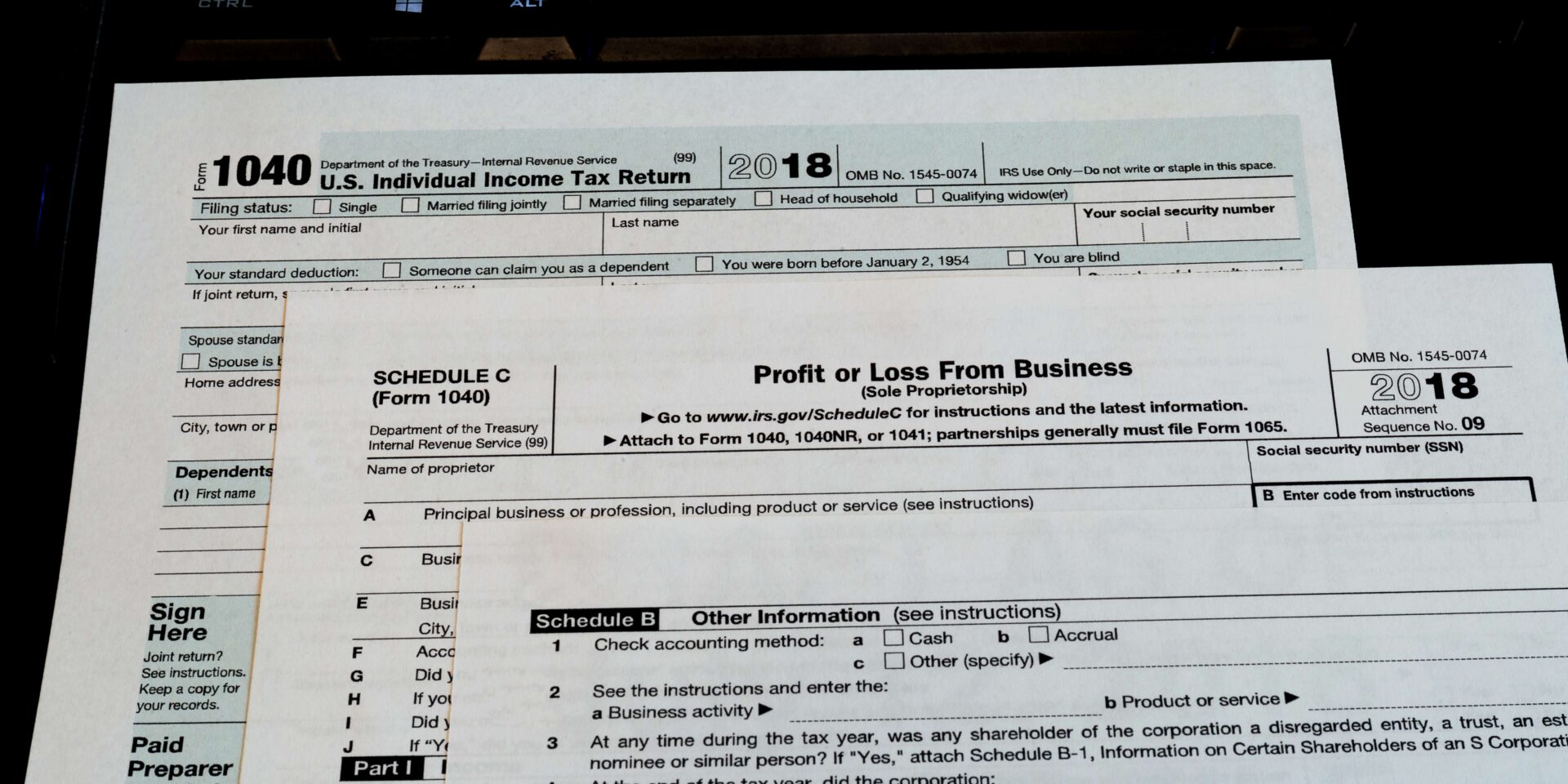Language:
Schedule C Loss Limit: What You Should Know

If you run your own business, have an LLC, or work as a sole proprietor, it’s likely you’ll need to become familiar with IRS Schedule C at tax time. This form is used for reporting business income and expenses for sole proprietors.
Freelancers, contractors, people doing side-gigs, and small business owners typically file IRS Schedule C with profit and loss reporting to their Form 1040 when filing taxes. Read on to understand the Schedule C loss limit in the United States, with key considerations and tips to save time and simplify filing this year.
Understanding the Schedule C Excess Business Loss Limitation
You use IRS Schedule C to report all business income and losses. According to the IRS, an activity qualifies as a business if you engage in the activity for the primary purpose of profit, and continue the activity regularly. By this definition, a hobby, activity without the aim of profit, or a sporadic activity does not qualify as a business activity.
You will also use Schedule C to report wages and expenses you had as an independent contractor or freelancer, income and deductions of certain joint ventures; and amounts shown on Form 1099, including Form 1099-MISC, Form 1099-NEC, and Form 1099-K.
If you report losses on line 31 of Schedule C of Form 1040, when you report business income and losses, the IRS sets business loss limitations. The disallowed loss from the limitation isn’t reflected in line 31 of Schedule C. Instead, you will use Form 461 to report excess business loss and then include the information on Schedule 1 of Form 1040, line 8p. You may carry forward any disallowed loss as a net operating business loss into a subsequent year.
For 2023, you can take a loss of up to $262,000 as an individual or $524,000 for a joint tax return.
How Does the IRS Schedule C Form 1040 Work?
IRS Schedule C is a tax form used for reporting your profit or loss from a business. The form is specifically used for freelancers, independent contractors, self-employed individuals, single-member LLCs, or sole proprietors.
You will need to fill out Schedule C and file it electronically with Form 1040, or attach it when you mail in your completed Form 1040 and any other required schedules. While you may need Form 1099 (usually 1099-NEC or 1099-K) in order to fill out a Schedule C, they are two distinct forms.
Who Is Required to File a Schedule C Tax Form?
Schedule C is primarily for sole proprietors or single-member limited liability companies (LLCs). C corporations and S corporations do not use Schedule C to report business income or losses.
Sole proprietorships are defined as unincorporated businesses owned and run by a single person. It is not a legal business entity. For example, if you open an Etsy shop or start offering online tutoring without forming an LLC or any other legal entity, you are usually treated as a sole proprietorship. It is one of the most common business structures for professionals who work as independent contractors, have a side gig, freelance, or operate a business by themselves.
A single-member LLC is a legal business entity with just one owner. LLCs have the advantage of pass-through taxation, which means there is no distinction between the LLC owner and LLC income for tax purposes. Business income and profits are reported on the owner’s personal tax return.
Even if you are an employee of another company and receive W-2s, you may have to file a Schedule C. For example, if you’re freelancing on the side, or have a side gig where you regularly earn income, you will need to report that income with Form 1040 and Schedule C.
Depending on your side gig, you may be required to report your income to the IRS on a different Schedule. If you have a side gig that earns rental income or royalties, you may need to fill out Schedule E. If you’re earning income from a farming side gig, you may need to fill out Schedule F.
Is Schedule C only for the Self-Employed?
Schedule C is not only for the self-employed. Even if you have a full-time job as an employee of someone else’s company, you may need to report income and losses for a side hustle or freelance gig on IRS Schedule C. In fact, if you have multiple side gigs in different industries, you’ll need to fill out a Schedule C for each side gig.
Do LLCs also File a Schedule C?
Yes, single-member LLCs also have to file Schedule C. If you have a single-member LLC, you will need to file Schedule C to report business income and losses.
What Information Is Required to Complete a Schedule C?
The information needed to fill out Schedule C includes:
- Your name
- Your Social Security Number
- Information on the business, including primary activity and business address
- Your accounting method
- Whether you started or acquired the business during the tax year
- All information on business income, including gross income
- All expenses, by category, including advertising, employee benefit programs, vehicle expenses, office expenses, insurance, and more
To fill out Schedule C, you will need your business income statement and balance sheet for the tax year, if available. You’ll also need receipts for all business expenses, plus mileage and other vehicle records if you have a business vehicle. If you have inventory, you will also need inventory records.
Finally, you will need to calculate the total net profit or loss and file the form with your Form 1040 and any other required tax forms.
How to Determine Net Profit or Loss for Your Business on a Schedule C?
To determine the net profit or loss of your business, you will need to deduct total expenses, reported on line 28 of Schedule C from total income reported on line 7. You can also use most major tax preparation software solutions or free tax filing software to automatically calculate your net profit or loss based on the inputted information to fill Schedule C for you.
How to Fill Out a Schedule C Form 1040?
If you choose to fill out Schedule C yourself, here is an overview of the step-by-step process.
- Gather all the required documents and information so that you can save time when filing.
- Fill in initial Parts A to J with basic information about yourself and your business.
- Fill in Part I with information on business income, minus the cost of goods sold.
- Fill in Part II with information on business expenses, including all relevant expense deductions.
- Fill in total business expenses in line 28.
- Calculate the total business profit or loss and input it in line 31.
- In line 32, if the business has a loss above the loss limit, report these losses and check the appropriate box. Then, carry over loss above limits and report it on Schedule 1 of Form 1040, or Schedule SE, line 2, depending on whether all business investment is at risk.
- Learn more about how to file taxes for LLCs with no income.
What are the Penalties for Not Filing a Schedule C Form When Required?
There are penalties for not filing Schedule C including fees or interest on fees. According to the IRS, you may have to pay interest and penalties on any understatements or failure to file.
Save More Time this Tax Year
If you have an LLC, it can offer significant liability protection along with LLC tax benefits. If you haven’t yet formed an LLC, you can get professional formation services to simplify administration, protect your assets, and more. doola’s business formation services can help with formation and compliance so you can save time this year.
But beyond formation, doola bookkeeping services are designed for busy founders to help businesses of all sizes streamline bookkeeping and file taxes easily. Get doola Books here!
FAQs
Can I include both full-time and part-time self-employment income on Schedule C?
Yes, you can include both full-time and part-time self-employment income on Schedule C. However, you will need to use a different Schedule C for each separate business or income stream.
Can I use a Schedule C if I operate my business as a corporation?
No, you cannot use Schedule C to report the profit and loss of a corporation. Instead, corporations must file Form 1120, unless they are required or elect to file a special return.
Are there any exceptions to filing a Schedule C?
There are exceptions to filing a Schedule C based on the business structure and type of income. If the company is a partnership, you will need to file Form 1065 instead. You may also need to report specific income on Schedule E, Schedule F, Schedule J, or other forms. You can find a complete list of exception schedules and forms here.
How do I report income from multiple businesses on Schedule C?
You cannot report income from multiple businesses on the same Schedule C. Instead, you must fill out a separate Schedule C form for each business. In case any of the businesses are corporations, you will need to report the income of that business on Form 1120.
Can I carry over a net loss from my business to future tax years on Schedule C?
No, you cannot carry over net loss from your business to future tax years using Schedule C. Instead, if your business losses exceed Schedule C limits, you need to use Form 461 and include it on Schedule 1 of Form 1040.
Keep reading
Start your dream business and keep it 100% compliant
Turn your dream idea into your dream business.















